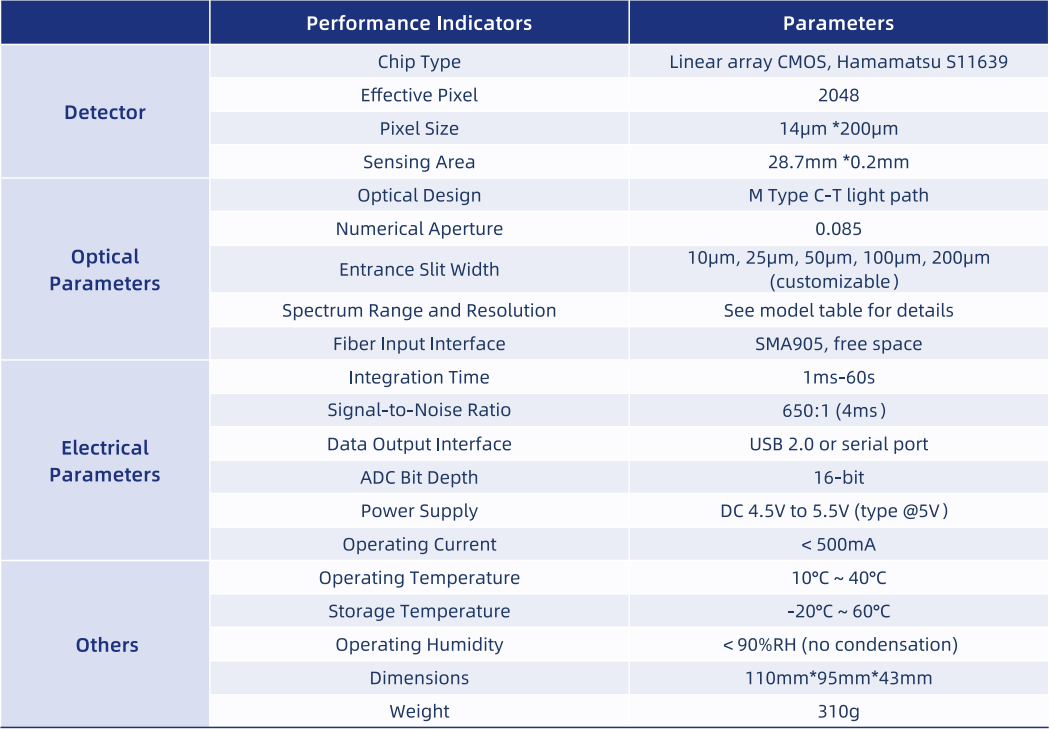In recent years, Laser-Induced Breakdown Spectroscopy (LIBS) technology has shown broad application prospects in fields such as geological research, deep space exploration, materials science, environmental monitoring, and biomedicine due to its advantages of no sample preparation, minimal sample damage, real-time analysis, and simultaneous multi-element detection.
1. Introduction to the Principle of LIBS
Laser-Induced Breakdown Spectroscopy (LIBS) operates based on the following principles:
● Excitation: LIBS technology uses a high-energy focused pulsed laser beam to excite the sample surface.
● Ablation: The surface is ablated, generating plasma, which is a partially ionized gas.
● Emission Spectrum: After the laser pulse ends, atoms and ions emit characteristic spectral lines as they return to their ground states.
● Spectral Capture: The spectrometer captures the spectra emitted by these elements.
● Analysis Process: By analyzing the wavelengths and intensities of these spectra, LIBS technology can identify the elemental composition of the sample.
Key features of LIBS include rapid direct analysis, minimal sample preparation, and the ability to detect nearly all elements. Below is a periodic table listing over 60 common elements that can be quantitatively analyzed using LIBS, along with the detection limits for different elements.

2. LIBS Measurement Scheme
2.1 System Setup
A typical LIBS measurement system involves the following components and process:
● The spectrometer provides a synchronous trigger signal to the laser.
● The laser emits a laser beam focused onto the sample.
● The returned light signal is collected by the receiving lens assembly within a specified time frame and directed into a multi-channel spectrometer (such as the JINSP SR75C series).
● The computer processes the collected data, displaying the spectral information and analyzing the types and quantities of elements present in the sample.

2.2 Characteristics of LIBS Applications
a. Wide Spectral Range - Diversity in Element Detection
LIBS offers a broad spectral analysis range, typically covering wavelengths from 200 nm to 1070 nm. This wide spectral range enables LIBS systems to detect and analyze a variety of elements, including many that have characteristic features in the visible and ultraviolet regions.
b. High Spectral Resolution - Accuracy in Element Detection
In LIBS systems, the combination of a wide spectral range with high resolution (such as an optical resolution of 0.1 nm or better) allows the system to distinguish subtle spectral features of different elements. This is particularly important for the analysis of complex samples. High resolution helps improve the accuracy and reliability of the analysis.
c. High Signal-to-Noise Ratio - Detection of Trace Elements
In LIBS experiments, suitable delay times and integration times are chosen based on different samples to achieve high signal-to-noise ratio spectra. High-sensitivity detectors also enable LIBS systems to detect elements at ppm (parts per million) levels. This means that LIBS systems can detect and analyze trace elements in samples, which is especially important in fields such as environmental monitoring and geological exploration.
d. Controllable Delay and Integration Time - Real-time Online Analysis of Element Detection
During the initial formation of plasma, bremsstrahlung and recombination radiation produce continuous background radiation. Only when the intensity of bremsstrahlung and recombination radiation decreases can the ion and atomic line spectra, formed by transitions between bound energy levels of atoms and molecules, be observed. The continuous background radiation lasts on the order of microseconds but decays quickly, while the intensity of discrete ion and atomic spectra slowly increases, typically requiring a few hundred nanoseconds. This period is the optimal window for detecting signals.
The SR75C high-resolution fiber optic spectrometer from JINSP meets all the required characteristics mentioned above. For more details, please visit(Best SR75C miniature spectrometer manufacturers and suppliers | JINSP (jinsptech.com)).
3.SR75C High-resolution Fiber Optic Spectrometer
3.1 Product Features
a. Wide Spectral Range - Covers 200~1000 nm
b. High Spectral Resolution - 10 μm slit: 0.15~0.2 nm
c. High Signal-to-Noise Ratio - 650:1
d. Controllable Delay/Integration Time - Adjustable delay from 0~10 μs
3.2 Product Specification Table
Post time: May-31-2024


